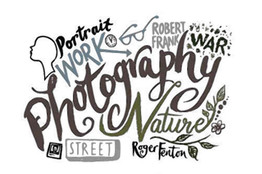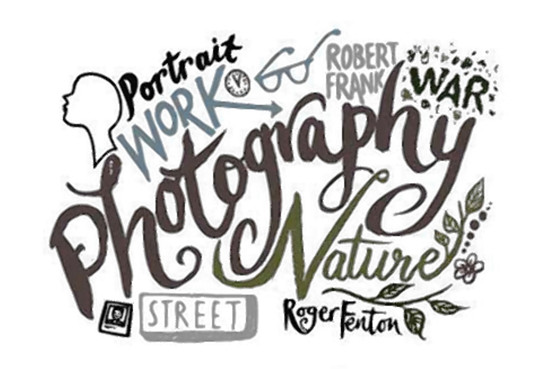The pictures in "Eliot Porter: In the Realm of Nature" (J. Paul Getty Museum, 144 pages, $39.95) are beautiful. Eliot Porter (1901-1990) and Ansel Adams were the two great American landscape photographers of the mid-century, but whereas Adams never abandoned black-and-white photography, Porter was an early champion of color. His mastery of the technically complex dye-transfer process let him produce prints with deep, rich colors. A scientist by training, Porter's modernist sensibility meant he was as concerned with the aesthetic design of his images as with their utility to naturalists: See the placement of the pink against the green in "Redbud and Tulip Poplar, Route 129 to Foothills Parkway, Great Smokey Mountains National Park, Tennessee" (1968), the splotches of rust color against gray in "Lichen on Round Stones near Flaajokull, South Coast, Iceland" (1972), or the Monet-like "Pool in a Brook, Pond Brook, near Whiteface, New Hampshire" (1953). For the last several decades landscape photographers have concentrated on showing man's depredations of nature, but their pictures only take on meaning when set against the images of untrammeled beauty by artists such as Porter.
Anne Wilkes Tucker, the distinguished curator of photography at the Museum of Fine Arts, Houston, spent 10 years assembling the material in "War/Photography: Images of Armed Conflict and Its Aftermath" (The Museum of Fine Arts, Houston, 604 pages, $90). A glance at the table of contents suggests its breadth: "The Advent of War," "Recruitment and Embarkation," "Daily Routine," "Reconnaissance, Resistance and Sabotage," "Grief and Battlefield Burials and Memorials," "Death," "Children," and considerably more. There are over 400 pictures taken by 280 photographers from 28 nations, starting with the 1840s and continuing to conflicts still in progress. Among the many well known images included are Roger Fenton's "The Valley of the Shadow of Death" (1855) and Larry Burrows' "Reaching Out (Operation Prairie, Mutter Ridge, Nui Cay Tri), Vietnam" (1966). But unfamiliar pictures are of equal interest, such as an aerial photo of the December 7, 1941, attack on Pearl Harbor taken by an unknown Japanese photographer, or the Ukrainian Gleb Garanich's touching image from 2008 of a Georgian man holding his brother's body following a bombardment during the Russian-Georgian war.
Chris Killip's "Arbeit/Work" (Edition Folkwang/Steidl, 136 pages, $68) is a selection of his elegiac black and white photographs from the 1970s and '80s documenting the end of industrial Britain. A 1975 picture taken in Tyneside, in northeastern England, shows workers' housing, three children playing in the street and a huge ship prophetically named Tyne Pride being serviced; a picture taken at the exact same spot in 1981 shows the housing mostly demolished, the street empty, and no ships; someone has painted on a wall "Don't vote. Prepare for revolution." Mr. Killip's portraits of members of the vanishing working class are enormously moving in both their pride and their despair. In several pictures we cannot see the subject's face, but the body language and details of clothing and place give an ample sense of personhood. A girl playing with a hoop on a litter-strewn beach, a bingo parlor, housing estates, men tending industrial machines, middle-aged women celebrating the Queen's Silver Jubilee: Chris Killip's England.
In her introduction to "The White House: The President's Home in Photographs and History" (Little, Brown, 230 pages, $35), editor Vicki Goldberg reminds us that it is called a "house" and not a "palace" because it is an embodiment of the country's republican ideals. Ms. Goldberg, the author of many acclaimed books on photography, selected images from the White House Historical Association's collection of 8,000 pictures, from the Library of Congress and the presidential libraries. The text begins with a daguerreotype from about 1846 by John Plume Jr., the earliest known photographic image of the White House, and concludes with Pete Souza's picture from January 20, 2009, of President Barack Obama and his wife in a freight elevator on their way to the Inaugural Ball. There are pictures of the presidents' families, staffs, servants and pets. Besides important state occasions such as Yitzhak Rabin and Yasser Arafat shaking hands within President Bill Clinton's symbolic embrace (1993), there are weddings, funerals, media events and personal moments. Ms. Goldberg's captions are lucid and full of surprises.
"Jitka Hanzlova" (T.F. Editores, S.L.C., 240 pages, $62) includes generous selections from the Czech photographer's major projects of the last three decades. Ms. Hanzlova is unique among the leading contemporary art photographers in being able to do more than one thing well. Her full-length color portraits are almost always revealing, and in her latest series, "There is Something I Don't Know," she explores Renaissance techniques, especially profiles that emphasize the subject's physical particularity. She has taken portrait series in her native Czechoslovakia, her adopted Germany, in Brixton (a section of London with a large black population), and in Japan, all predominantly of women. In "Forest" she is neither a naturalist like Eliot Porter, nor an environmentalist like Robert Adams, but a romantic. Her somber forests, like Robert Frost's woods, are "lovely, dark and deep," places where one can lose one's social being and find a more elementary self. Her occasional cityscapes are idiosyncratic, and her pictures of flowers show she understands that there is beauty in decay.
"The Americans List" (Red Hook Editions, 85 pages, $10) is not a photo book, but a book about a photo book. Photographer Jason Eskenazi was working as a guard at the Metropolitan Museum of Art during its exhibition celebrating the 50th anniversary of the publication of Robert Frank's "The Americans" (1958). Mr. Eskenazi polled 276 photographers he recognized going into the exhibition as to their favorite picture, and collects their responses here. The photographers' explanations of their choices make clear why "The Americans" is easily the most influential photo book of the post-war era. John Trotter chose "Trolley – New Orleans": "The disturbing power of the white peoples' eyes in this photo . . . never quite left me. I had been taught not to stare at people. This image though, taught me that becoming a documentary photographer was about not looking away." Most of the responses are similarly visceral. Joel Meyerowitz, Ralph Gibson, Jeff Mermelstein, Eugene Richards, Mary Ellen Mark and Annie Leibovitz pick their favorites–as does Robert Frank himself.
–Mr. Meyers writes on photography for the Journal. His photographs are currently on display at the Nailya Alexander Gallery.
Explore More
-
Accident Puts New Spotlight on Rail Safety
Long before this week's deadly collision in Midland, Texas, federal safety watchdogs highlighted railroad accidents as some of the most serious, but also among the most readily preventable, types of transportation hazards across the U.S.
-
Subscriber Content Read Preview
Applicants Rise for Immigration Program
About 300,000 young illegal immigrants have applied for a reprieve from deportation under a new immigration program and 53,273 cases have been approved compared with 180,000 applications and 4,591 approvals through mid-October.
-
Subscriber Content Read Preview
![[image]](wsj_giftguide_2012%20Files/OB-VJ784_1116mi_C_20121116151808.jpg)
Fathers, Husbands, Sons Remembered
-
Subscriber Content Read Preview
Affair Highlights Uncertainty of Email-Privacy Laws
The adultery scandal that short-circuited David Petraeus's career also shined a light on the peculiar legal standards governing the privacy of email.
-
![[image]](wsj_giftguide_2012%20Files/OB-VJ784_1116mi_C_20121116151808.jpg)
In Texas Crash, Veterans' 'Stolen' Souls
-
Subscriber Content Read Preview
Medicare Premiums to Rise $5 a Month
Most Medicare beneficiaries will pay monthly premiums of $104.90 next year for coverage of doctors' services in the federal health program for the elderly, a $5 increase on the 2012 rates.
-
Subscriber Content Read Preview
Settlement Reached in Slaughterhouse-Abuse Case
A $500 million settlement was reached in a slaughterhouse-abuse case that led to the biggest meat recall in U.S. history in 2008, but the deal is largely symbolic because the company is bankrupt.
-
Subscriber Content Read Preview
![[image]](wsj_giftguide_2012%20Files/BF-AD840_17FHA_C_20121116172405.jpg)
FHA Moves to Avert Injection
-
Subscriber Content Read Preview
States Brace for Possibility Deal Fails
State budget chiefs have begun setting aside money and looking for programs they can quickly scale back if leaders in Washington fail to avoid the so-called fiscal cliff.
A version of this article appeared November 17, 2012, on page C11 in the U.S. edition of The Wall Street Journal, with the headline: No Headline Available.

















![[image]](wsj_giftguide_2012%20Files/OB-VJ950_1118is_A_20121118103814.jpg)
![[image]](wsj_giftguide_2012%20Files/OB-VJ798_wiiu_A_20121116155406.jpg)
![[image]](wsj_giftguide_2012%20Files/RV-AI825_VOLATI_A_20121116195025.jpg)
![[image]](wsj_giftguide_2012%20Files/RV-AI771_VISUAL_A_20121116012835.jpg)
![[image]](wsj_giftguide_2012%20Files/BF-AD858_CHOU_C_20121116174910.jpg)
![[image]](wsj_giftguide_2012%20Files/OB-VI434_1113pe_C_20121113103049.jpg)
![[image]](wsj_giftguide_2012%20Files/NA-BT713_GOPSEN_C_20121116181624_002.jpg)
![[image]](wsj_giftguide_2012%20Files/WO-AL744_CPREMI_C_20121116172617.jpg)
![[image]](wsj_giftguide_2012%20Files/OB-VJ913_myanso_C_20121116224549.jpg)




Most Recommended
’ÄúThe Obama Administration is livi...;’Äù
’ÄúFORWARD!;’Äù
’ÄúAtlas shrugged;’Äù
’ÄúFor some reason, they were under...;’Äù
’Äú""It was a very, very...;’Äù